|
< Earlier Kibitzing · PAGE 3 OF 3 ·
Later Kibitzing> |
| Nov-01-05 | | patzer2: On second thought, I think I'll put yesterday's puzzle solution 28. Rh7+! in my decoy collection, instead of calling it a deflection. Reinfeld was not incorrect in classifying this problem as a "removing the guard" tactic (number 480 on page 99 in 1001 Winning Chess Sacrifices and Combinations). However, it seems to me that the key idea of the combination is the decoy (forcing the King to a critical square). Once this objective (decoying the King to h2) is realized, the mate which follows is easy. |
|
| Dec-04-05 | | notyetagm: <patzer2> I disagree. To me this tactic is a <deflection> because the Black king is overworked. The Black king has to keep the White h1-rook out of h7 and the White f3-queen out of f7 and it cannot do both since a king defends only one square. By making the Black king meet the threat to h7 with 28 ♖h7+! ♔xh7, the king is <deflected> away from its defense of the critical f7-square. |
|
| Dec-04-05 | | notyetagm: For the most stunning example of this theme that I have ever come across, be sure to check out Judit Polgar's incredible 24 ♖d7!! from Judit Polgar vs J Fernandez Garcia, 2003. This remarkable move is neither a check nor a capture but yet it forces mate in all variations. |
|
| Dec-04-05 | | Calli: 23...g5? is not Dr. T's best idea. |
|
| Dec-04-05 | | notyetagm: Also checkout my note in Chen Fan vs Bu Xiangzhi, 2005 as to why White cannot move his c3-knight after 18 ... b4. Why not? Because the <king deflection> 19 ... ♖xa2+! 20 ♔xa2 ♕xc2+ forces mate, that's why not. The mating line would look something like
19 ♘d5?? ♖xa2+! 20 ♔xa2 ♕xc2+ 21 ♔a1 ♖a8+ 22 ♗a7 ♖xa7+ 23 ♗a6 ♖xa6+ 24 ♘a5 ♖xa5#. |
|
Oct-15-09
 | | tamar: 23...g5 is disastrous, but even against 23...Ne7 24 g5 Nxf5 25 exf5 d5 26 Qh5 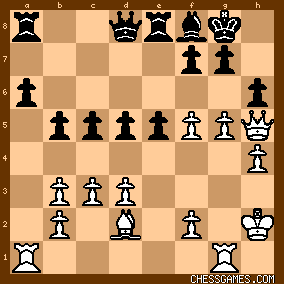
click for larger viewWhite's threats of g6 and gxh6 are winning. |
|
| Jan-14-10 | | James Demery: I thought HP preferred 1e4? |
|
| Jan-14-10 | | James Demery: I meant 1d4. |
|
| Jan-15-10 | | AnalyzeThis: I don't know who the strongest player all time was, but in my mind, Pillsbury played the most interesting chess. |
|
| Jan-15-10 | | visayanbraindoctor: <AnalyzeThis: I don't know who the strongest player all time was, but in my mind, Pillsbury played the most interesting chess.> Among native born American chess masters in the era of the chess clock, IMO the strongest ones (intrinsically) in order are: Fischer
Pillsbury
Fine
Marshall
Morphy was active in a time where there were no chess clocks, and probably messy tournament conditions, so it is hard to compare him with his successors. However, if he was born a hundred years later, he could have churned out performances as impressive as Fischer's for as long a period of time. |
|
| Dec-30-21 | | jerseybob: <visayanbraindoctor: <AnalyzeThis: I don't know who the strongest player all time was....Morphy was active in a time where there were no chess clocks, and probably messy tournament conditions, so it is hard to compare him with his successors.> I love Alt-History, in chess as much as in anything else. So for what it's worth....If Morphy were magically beamed up to the present time and plopped down in front of modern GMs, he'd have troubles...at the start! But eventually his talent, a talent that Bobby Fischer highly respected, would bring him up to speed. And of course he'd have his youthful energy and a desire to improve his game, 2 more stipulations in my scenario. |
|
Dec-10-23
 | | KEG: A true heavyweight contest at a critical moment at the Monte Carlo 1902 tournament. With five rounds to play, the standings were: Maroczy-- 11.5
Pillsbury-- 11.0
Marshall-- 10.0
Janowski-- 10.0
Tchigorin-- 9.75 [with one bye round remaining]
Tarrasch-- 9.50
Teichmann-- 9.0 [with two 1/2 replays in hand] Maroczy had been leading for most of the tournament, aided by his victory over Pillsbury in Round 1.
Pillsbury had been fighting hard to catch Maroczy
Janowski had started strong but fell back some losses
Marshall had been lucky, and his luck was about to run out.
Tchigorin, with one game less to play, was not really in fifth place.
Tarrasch had gotten off to a horrific start (three losses and a draw in his first four games) but had been pressing hard to catch up since then
Teichmann, with replays that were potentially worth a full point in the aggregate, was perhaps truly ahead of Tchigorin and Tarrasch. By winning this game, coupled with Maroczy's loss in this round, Pillsbury at last took the lead. This ultimately got him second place when he faltered in later replays against Tchigorin and Marco while Maroczy went undefeated the rest of the way. Tarrasch still had a chance to win the tournament. His remaining five games included contests with Pillsbury, Teichmann, and Maroczy. Had he won all five games, and with all the other results being what they were, Tarrasch would indeed have won the tournament. His loss in this game, later followed by a loss to Teichmann and two draws with Maroczy, left him tied for 5th place. Pillsbury and Tarrasch, from their first meeting at Hastings 1895, had an explosive rivalry. Going into this game, the score was four victories apiece and only one draw, That draw was in the final game of their playoff match at Vienna 1898, and allowed Tarrasch to win that event. They played twice more at Monte Carlo 1903, Tarrasch winning one and drawing the other, therefore ending the rivalry at 5 wins apiece in 12 games. This game, like all the other Pillsbury-Tarrasch games, had fireworks, and Pillsbury prevailed with a sparkling winning combination. Much of the commentary on this game mocks Tarrasch's play. Much of this criticism, as I will attempt to show, was grossly wide of the mark. Through Pillsbury's 21st move, this was a close affair with fine judgment by both players--until Tarrasch's poor 21st move, after which he appeared to panic when he saw he was in trouble and got destroyed by Pillsbury's brilliant play. All-in-all, this game is a worthy addition to the Pillsbury--Tarrasch rivalry. 1. e4 e5
2. Nf3 Nc6
3. Bb5 a6
4. Ba4 Nf6
5. 0-0 Be7
6. Nc3
While 6. Re1 became more popular, there is nothing wrong with the text. 6... b5
7. Bb3 d6
8. d3

click for larger viewPillsbury knew this line well as White, having drawn from here against Schlechter at Vienna 1898 and then defeating Schlechter when they repeated the above moves at Paris 1900. 8... Na5
This was denounced as loss of time by the contemporary commentators: "As Black does not take the Bishop, this appears to be loss of time" (Sergeant/Watts in their book on Pillsbury) "Black loses time by this inactive move and White utilizes the time gained by playing Ng3." (Gunsberg) This strikes me as the worst form of Monday-morning-quarterbacking. While it is true that Tarrasch never did play NxB, that--as will be seen--is a function of how the game developed. There is nothing wrong with Tarrasch's move from where I sit. 9. h3
Seemingly tentative play by Pillsbury. I might have expected 9. Qe2 or 9. Bd2 from the American whiz. But, as will be seen, Pillsbury is already looking towards a King-side assault, the the text fits in well with his notion. It also gave Tarrasch no reason to hurry with 9...NxB. 9... 0-0
Come and get me!
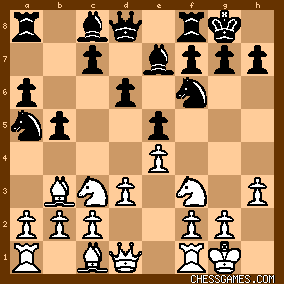
click for larger view |
|
Dec-11-23
 | | KEG: Post II
10. Ne2
The engines don't much care for this move, but it nevertheless was part of Pillsbury's attacking scheme: Ne2-g3 and later Ng5. Pillsbury had defeated Schlechter after playing this move at Paris 1900, so it should not have come as a surprise to Tarrasch. 10... c6
"Again loss of time as he plays c5 two moves later." (Sergeant/Watts) "A loss of time. 10...c5 was stronger. The idea is to plau Qc7 and d5." (Tournament Book) 10...c5 is arguably stronger, but the text was also good, the above authorities notwithstanding. As with the critiques of Tarrasch's 8th move, what seems to be overlooked is that Tarrasch in both cases was keeping his options open. The text, like 10...c5, permits 11...Qc7 (which Tarrasch sure enough played on his next move), but also allowed him the option of playing to stop Pillsbury from occupying d5. At the same time, c5 would still be available as a possibility, and as the game developed, Tarrasch did indeed play c5 on move 12. 11. Ng3
The reason for 10. Ne2.
11... Qc7
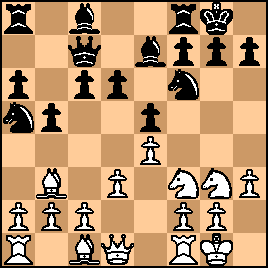
click for larger view12. Qe2
A true "Pillsbury attacking preparation" move. Now that Pillsbury had showed his hand, Tarrasch proceeded to play: 12... c5
With all the supposed "loss of time" by Tarrasch, did he really have such a bad game at this point?: 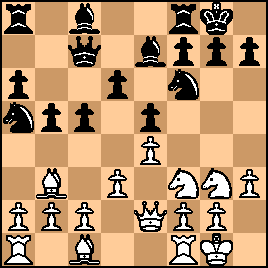
click for larger viewOne can debate the merits of the respective positions here, but surely Tarrasch was in no danger at all at this point. The engines give the game as approximately equal, whatever that means (computer engines, in my opinion are notoriously poor in evaluating such positional considerations). 13. Bd2 Nc6
"?"--(Tournament Book)
"Inconsequential. The object of his 8th move was to exchange the Bb3." (Tournament Book) Actually, the object of Tarrasch's 8th move was to give himself the OPTION of trading Knight for Bishop. As the game had developed, however, it was no longer clear that the B3 White Bishop was superior to the Black Knight in this closed position. As a check, let's have another look at the board: 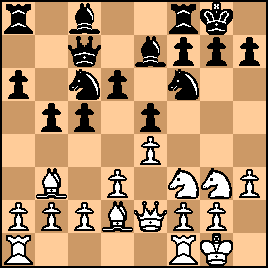
click for larger viewNot a bad position for Black after allegedly having committed three positional blunders. 14. c3 Be6
"14...Bd7 was better." (Sergeant/Watts)
"Better 14...Bd7." (Bachmann)
Really? Is White's position after 14...Bd7 15. Nh4 noticeably inferior to what occurred in the game? In fact, Tarrasch has decided to trade off the White Bishop on b3 just as all the commentators claimed he should have. The difference is that he uses his Bishop rather than his Knight to get rid of the White light-square Bishop. The text left:
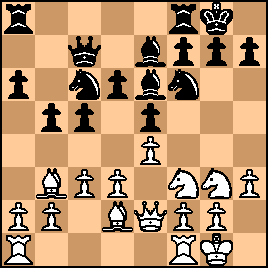
click for larger viewFor all his supposed positional blunders to this point, Tarrasch's position looks remarkably sound. So maybe--just possibly--Tarrasch's judgment was better than was his detractors, at least to this point. |
|
| Dec-11-23 | | Granny O Doul: I wonder if these guys ever had to deal with the Breyer system? 1. e4 e5 2. Nf3 Nc6. "As the knight shortly returns to b8, this move is a clear loss of time". |
|
Dec-11-23
 | | perfidious: The earliest examples in this DB are three games from 1954, including: V Zagorovsky vs G Borisenko, 1954 |
|
Dec-11-23
 | | Honza Cervenka: Maybe 19...Ne7 and definitely 20...Ne7 were better moves. After 20...Qd8? white attack got momentum and it was hardly possible to stop it. 23...g5(?) was a desperation in already bad position. |
|
| Dec-11-23 | | Granny O Doul: @perfidious: That seems bizarre. On the other hand, Breyer's ice cream today is a far cry from what William A. Breyer first concocted. In its last throes, you might even say. |
|
Dec-11-23
 | | NM JRousselle: The move I have trouble understanding is 13...Nc6. What was Tarrasch thinking? Why did he not capture the Lopez bishop? |
|
Dec-12-23
 | | KEG: <NM JRousselle> Tarrasch seems to have decided to retain his a5 Knight in this closed position. Instead, he played 14...Be6 to be able to trade off the "Lopez bishop" with his own Bishop. Indeed, Black frequently decided to allow this bishop to live. If the trade were always desirable, Black could just...after 4. Ba4, just play 4...b5 followed by 5...Na5 and then 6...NxB. Indeed, had Tarrach made better use of this Knight later in the game (e.g., playing 19...Ne7 or 20...Ne7 or 21...Ne7) he seemingly would have been OK. Given that Tarrasch emerged with a decent position from the opening, I am loathe to fault his judgment here (though, I must admit, his idea did not initially occur to me at all in playing over the game. |
|
Dec-12-23
 | | KEG: <Honza Cervenka> I agree with your comments completely. I will incorporate your thoughts in my upcoming posts on this game. |
|
Dec-12-23
 | | KEG: Post III
15. Ng5
"!"--(Gunsberg)
"White's object is to compel Black to exchange bishops and thereby gain an excellent footing for his Knight on f5." (Gunsberg) Here we go again. Every move by Tarrasch gets denounced while everything Pillsbury played is a depicted as the work of genius. Yet, Tarrasch still has a decent game! By my lights, Tarrasch was happy to trade Bishops. He lost the game because of his upcoming errors, some of which have already been identified by <Honza Cervenka> Pillsbury did indeed get to play Nf5 without having to worry about a pesky light-square Black bishop. But, as we shall see, and as <Honza Cervenka> has already pointed out, this entire attacking scheme by Pillsbury was successful because Tarrasch--strangely--repeatedly failed to play the prophylactic ...Ne7. 15... BxB
If it were really so important to retain this Bishop, Tarrasch could have played 15...Bd7 or even 15...Bc8. But Tarrasch decided the text was best, and his judgment seems spot on. 16. axB
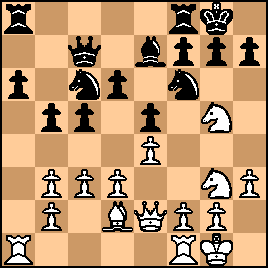
click for larger viewNow, after everything that has been said by the commentators, is Pillsbury so much better. For whatever it's worth, Stockfish's evaluation is (-0.05) and that of Fritz15 is (0.00). I'm not taking these ratings to the bank, but they do suggest that the wild criticisms of Tarrasch's play to this point were way off base. And while we're on the subject, let's listen to more Tarrasch trashing: 16... h6
"Weakening the king's side. 16...Ne8 was better." (Deutsche Schachzeitung) Huh? 16...Ne8 would lead to 17. Nf5 after which Black would clearly have the inferior game. The text is surely better. The real question is whether Tarrasch should have played 16...g6. He likely selected the text instead, preferring to weaken the light squares around his King rather than weaken the dark squares because Pillsbury's remaining Bishop was on d2 (a dark square). Nonetheless, the text--rather than 16...g6--appears to be a small mistake by Tarrasch. 17. Nf3 Rfe8
Allowing Bf8 on his next turn in anticipation of Pillsbury's potential attack. 18. Nf5 Bf8
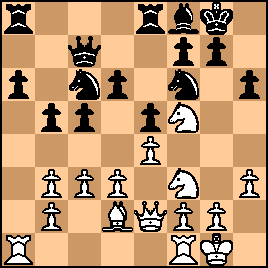
click for larger viewThe position towards which both players appear to have been aiming. 19. g4?!
I have not seen a hint of criticism of this move, though it is clearly premature. Pillsbury could better have prepared his intended King-side assault with 19. Nh2 (freeing the Queen to come to f3) or perhaps tried 19. c4 or 19. Ne3 (followed by 20. c4). But let's go back to trashing Tarrasch, shall we: 19... Nh7
"?"--(Sergeant-Watts)
19...Ne7, as given by <Honza Cervenka) was probably best. Tarrasch could later follow up with ...d5, leaving him with at least equal chances. But even after the text, Tarrasch was hardly in any sort of ghastly trouble. 20. Kh2
Given that Pillsbury later played 25. Kg2, I reckon that had it been Tarrasch playing the text he would have been faulted for "loss of time." In any case, after 20. Kh2, the position was:
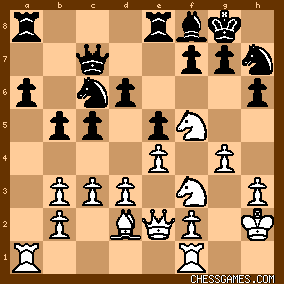
click for larger viewCheat code. Both Stockfish and Fritz rate the game after the text as about equal. What does that say about the original contemporary commentary on this game? For now, keep an eye on Tarrasch's two Knights. If properly utilized from here, they could have held the game easily for Black. In fact, Tarrasch's upcoming use and non-use of these pieces would soon cost him the game. |
|
Dec-12-23
 | | perfidious: <KEG....Here we go again. Every move by Tarrasch gets denounced while everything Pillsbury played is a depicted as the work of genius. Yet, Tarrasch still has a decent game!> While I am no fan of the excesses committed in the name of silicon assistance, their existence now spares us of what Nunn once wrote as annotations which purported to show that the winner got everything right and how the loser did everything wrong. <fishie> and company now ruthlessly bare every imprecision. |
|
Dec-13-23
 | | KEG: <perfidious> Well put. |
|
Dec-13-23
 | | KEG: Post IV
20... Qd8
"?"--(<Honza Cervenka>) I agree with <Honza Cervenka> that 20...Ne7 would have been better. 20...d5 and 20...Na5 were also superior to the text. But I don't think Black's position was anywhere hopeless...yet. 21. Rg1
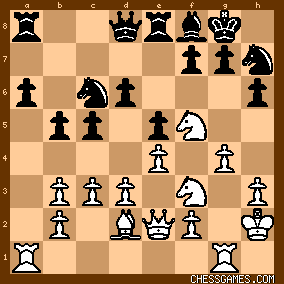
click for larger view21... Ng5?!
"In the vain hope of being able to stop White's well directed advance." (Gunsberg) The text creates weaknesses in the Black King-side that likely were beyond repair. The text practically invited Pillsbury's response and gave the brilliant American the sort of attacking opportunities at which he excelled. Black had many alternatives that would have given him realistic ways to hold the game: e.g., 21...Na5; 21...Re5; 21...Be7; and, of course, 21...Ne7 22. h4!
Of course!
22... NxN+
Not very pleasant for Black, but Tarrasch had nothing better here. 23. QxN
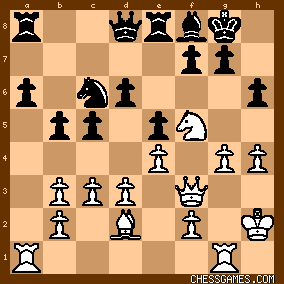
click for larger view23... g5?
Rightly called "desperation" by <Honza Cervenka>. But in fairness to Tarrasch, to quote Gunsberg: "There was no good way of stopping g5." If instead 23...Ne7, White wins after 24. g5 NxN 25. exN Ra7 [25...d5 26. Qh5 would be even worse for Black] 26. gxh6 Qxh4+ 27. Kg2 g6 (best) 28. Kf1, 23...g6 also loses after 24. Bxh6 since now 24...pxN gets crushed by 25. gxf5+ and Black not stave off mate for very long. 24. hxg5
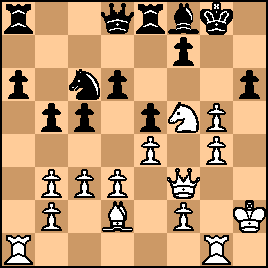
click for larger viewBlack is clearly busted.
24... hxg5
If instead 24...Na5 White wins after 25. Be3 [other moves also do the trick here for White[ 25...Nxb3 26. Ra3 c4 (best) 27. dxc4 bxc4 28. gxh6 25. Kg2!
Similar to the quite King move Pillsbury played in his brilliant win at Hastings 1895 over Tarrasch. The text here left: 
click for larger viewThe stage was now set for a brilliant finish by Pillsbury. Tarrasch's further moves--which suggest he was pretty much resigned to defeat--only accelerated White's fine finale. |
|
Dec-16-23
 | | KEG: Post V
25... Re6?
Tarrasch seems to have been too discouraged to put up any fight in his probably already lost position. Or perhaps he simply didn't see what was coming because of the approaching move-30 time control. The only glimmer of hope lay in bringing the a8 Rook to the defense via 25...f6 followed by 26...Ra7 or 25...Ra7 followed by 26,,,f6. 26. Rh1
Pillsbury immediately got his Rook on the lethal (for Black) open file: 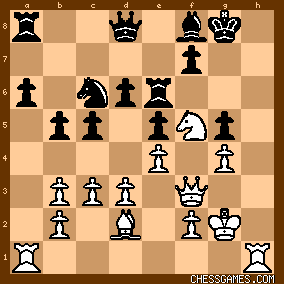
click for larger view26... Bg7
"?'--(Gunsberg)
"A blunder. Black must first play 26...Rg6 27. Qh3 Bg7"--(Bachmann) 26...Rg6 would not have saved the game, since Pillsbury would surely have responded 27. Rh5 (rather than Bachman's much weaker 27. Qh3). In any case, Black is dead, and further faulting Tarrasch here seems churlish. Pillsbury was now poised for a truly elegant finish: 27. NxB KxN
27...Rg6 would have allowed Tarrasch to stave off mate for a bit, but it was also entirely hopeless. The text allowed Pillsbury to his tactical genius, the position now being: 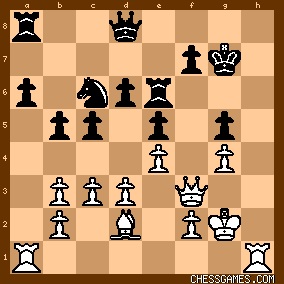
click for larger viewWhite to mate in four.
Not all that hard when presented as a problem:
28. Rh7! KxR
Anything else leads to mate on the next move:
29. Qxf7+
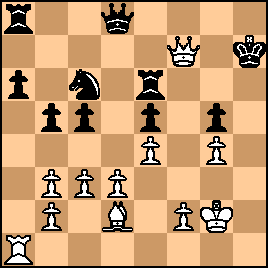
click for larger view1-0
Black can now only delay mate by one move (i.e., 29...Kh8 30. Rh1+ Rh6 31. RxR mate). |
|
 |
 |
|
< Earlier Kibitzing · PAGE 3 OF 3 ·
Later Kibitzing> |
|
|
|





